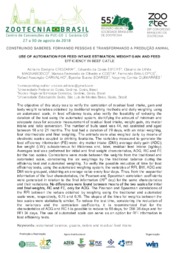Use of automation for feed intake estimation, weight gain and feed efficiency in beef catle.
Use of automation for feed intake estimation, weight gain and feed efficiency in beef catle.
Autoria: CROZARA, A. S.; EIFERT, E. da C.; MAGNABOSCO, C. de U.; COSTA, M. F. O. e; LOPES, F. B.; CARVALHO, R. A.; SOARES, B. B; GUIMARÃES, N. C.
Resumo: The objective of this study was to verify the correlation of residual feed intake, gain and body weight variables obtained by traditional weighing methods and daily weighing using an automated scale, in feed efficiency tests, also verify the feasibility of reducing the duration of the test using the automated system, identifying the amount of minimum and adequate days for accurate measurement of residual feed intake, weight gain, dry matter intake and ratio conversion. The number of bulls used was 44, not castrated and aged between 18 and 21 months. The test had a duration of 70 days, with an initial weighing, four intermediate and final weighing. The animals were also weighed daily by means of electronic scales coupled to drinking fountains. The variables measured to generate the feed efficiency information (FE) were: dry matter intake (DMI); average daily gain (ADG); live weight (LW); subcutaneous fat thickness and, later, residual feed intake (kg/day). Averages test was performed for initial and final weight characteristics, ADG, RC and FE for the two scales. Correlations were made between the weights from the traditional and automated scale, considering the six weighings by the traditional balance during the efficiency test and automated weighing. To verify the possible reduction of time for food efficiency tests, using the automated weighing system, the variables of RFI, BW, ADG and DMI were grouped, obtaining an average value every four days. Thus, from the sequential information of the four characteristics, the Pearson and Spearman correlation coefficients were generated in relation to the final information (70th day) for the same characteristics and their variations. No differences were found between means of the two scales for initial and final weights, RC and FE, only for ADG. The Pearson and Spearman correlations of the RFI between the values obtained by weighing using the traditional and automated scale were, respectively, 0.75 and 0.76. The slopes of the lines for weights between the two scales were statistically similar. To reduce the test time, considering the reduction of the variances and the correlation coefficients, it is recommended that for the characteristics of ADG and RC it is possible to reduce to 58 days, for DMI 38 days and for RFI 34 days. The use of automated scale can serve as an option for RFI information in food efficiency tests.
Ano de publicação: 2018
Tipo de publicação: Parte de livro (capítulos de livros, trabalhos e resumos publicados em anais ou em coletâneas)
Unidade: Embrapa Arroz e Feijão
Palavras-chave: Gado Guzerá, Gado Nelore, Ganho de Peso
Observações
1 - Por padrão são exibidas publicações dos últimos 20 anos. Para encontrar publicações mais antigas, configure o filtro ano de publicação, colocando o ano a partir do qual você deseja encontrar publicações. O filtro está na coluna da esquerda na busca acima.
2 - Para ler algumas publicações da Embrapa (apenas as que estão em formato ePub), é necessário ter, no celular ou computador, um desses softwares gratuitos. Sistemas Android: Google Play Livros; IOS: iBooks; Windows e Linux: software Calibre.
Acesse outras publicações
Acesse a Base de Dados da Pesquisa Agropecuária (BDPA) para consultar o acervo completo das bibliotecas da Embrapa.

